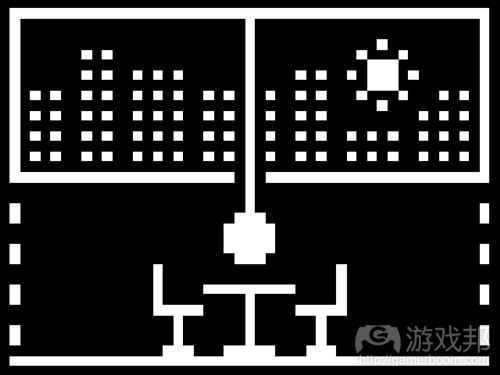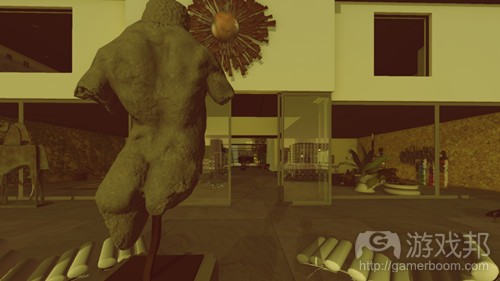从《Sunset》看电子游戏中的现实性
作者:Michael Samyn
在使用少量预算独立创造一款电子游戏时,你主要需要考虑的事是你的游戏最终会如何呈现以及与那些受欢迎游戏之间的比较。在商业电子游戏领域正上演着激烈的竞赛,即一些大型公司尝试着在美学方面超越其他竞争者。他们会不断在现实性,细节,场景等等方面加大赌注。而作为一名独立开发者的你只能张大着嘴巴敬畏地看着这一切。这便是Antewerp的居民在首次看到Rubens的作品时的感受。或者是在Ghent的Saint Bavo大教堂人们看到Van Eyck的祭坛画时的反应。
关于这种不可能的竞争(游戏邦注:因为独立开发者没有足够的预算)的最受欢迎的解决方法便是回归复古。故意创造老式游戏能够有效节省时间并能够将用户带进怀旧思绪中。就像在《Sunset》中,这是一个非常有趣的探索领域,特别是这款游戏还是以《Pong》发行的1972年为背景。但我们决定倍道而行。
原因在于我们非常欣赏Rubens和Van Eyck。正是这种美学将我们首次带到电子游戏领域。我们想要创造你能够访问并且在此与角色进行互动的艺术区域。我们想要感受到环境的包容并将自己沉浸于这种氛围中。但是我们是否有钱做到这点呢?
多即是少
在关注于我们对于电子游戏的美学的反应并了解了别人的感受后,我们有了一些特别的发现。对于所有致力于现实性的努力,当游戏越接近这种现实性时,越少玩家会在乎它。
当然了,你考虑这点是有意义的。我们玩电子游戏是为了将自己带到一个想象世界中,暂时摆脱现实世界。所以当游戏开始接近现实世界时,我们便会选择忽视它。在一开始我们可能会有“哇”的反应。但是当再出现一些逼真的垃圾桶和真实的棕榈树时,我们便不会再被吸引。
我并不是说这样的努力是白费的。最初的“哇”元素的影响力并不能被低估。这种观察力能够提供给我们这些缺少资金的独立开发者潜在的机遇。
爆炸的艺术
这不只是推动我们在《Sunset》中效仿的实际原因。从概念上讲,现实性是很简单的。这也是它在技术主导的领域中普遍存在的原因之一。复制你所看到的事物是一种简单的理念,能够提供一个明确的目标让你去对比自己的付出。如果完全按照这种理念去执行,那便不需要任何艺术上的创造性思维。
但就像上述所提到的,绝对的现实性也是绝对的愚蠢。我们是人类,所以我们喜欢与其他人类维系在一起。当我们着眼于一张图时,我们会注意到它的创造者,这是非常微妙的。我们喜欢观察艺术家是如何解决一个特定的传达问题。也许是因为它能够告诉我们一些有关创造了这张图的人的信息,或者关于他们尝试着去唤醒的内容。再或者只是因为它能够提醒我们这是由像我们一样的人,而非机器所创造出来的作品。
我相信这样的理论,即源自Raph Koster在《Theory of Fun》中所说的,艺术是发生在缺少现实性的地方。即脱离现实性的图片便是能够传达某些事物的艺术品。
然而这并不意味着绝对非现实图像便拥有更棒的效果。抽象和现实之间的张力非常重要。我非常享受沉浸于思考一些看似非常真实,但是在进一步考量后却发现并非如此的内容。特别是当抽象在某种程度上具有意义的时候。
实际建模对象很容易被识别出来并遭遇忽视。但一些看起来并不真实的事物却会吸引我们进一步研究。这只不过是因为我们的脑子里想着“为什么我不能忽视这样的事物呢?”
《Sunset》中的风格化
我们用于将《Sunset》带离现实性所使用的一种技巧是夸大夕阳的效果。从现实上看,日落的时候太阳的光线会慢慢变弱,而天空的光线则会增强。即在日落的时候整个世界会变暗变蓝。但是在我们的游戏中,日落会让世界的颜色趋于饱和,且呈现出橙色。而人们之所以会知道这是日落是源于太阳本身的颜色。
另外一种风格选择便是我们花了许多年时间并基于有限的预算而创造出的半现实外观的游戏。基于Fumito Ueda曾经对于《Ico》的描述,我们尝试着将注意力放在那些重要的元素中,并确保其它元素足够简单。这一方法能够与特殊的七十年代风格(游戏邦注:以其简单的现代主义架构带给我们灵感)有效地融合在一起。
而脱离现实性的副作用在于照片会显得非常奇怪。游戏中有很多Ortega的家庭照,还有报纸和杂志。所以Auriea创造了一种结合了照片拼贴画,半条图效果以及图纸的风格,从而让图片不仅看起来像照片一样,同时还会让人觉得它是属于我们的风格化公寓的一部分。
这便是我们的美学动机的核心:事物应该让人觉得是真实的,但是看起来却不是这样。在媒体中,图像的创造是综合的,而不是逼真的,风格化将帮助我们感受到它的真实性。因为风格化总是趋于主观,如此艺术家便可以引导观众去决定自己所认为的情感爆发处。
小小的玩笑
风格化的一个极端例子便是《Sunset》的最低质量模式。它的出现是为了让游戏可以在没有适当图像处理器的时候运行于计算机上(例如从理论上看那些综合事物只能以3D模式运行)。但是如果不考虑阴影和反射,动画角色以及大多数图像效果的话,我们便能够创造出不错的效果,不过游戏可能会显得较平淡。所以我们添加了一个像素画且具有多色调的效果到该模式中。这下看起来好多了。此外,这一模式更容易作用于第一人称中的晕动症。
逃离现实性
《Sunset》主要是基于一定的现实比例进行创造,并为了实时3D电子游戏的呈现而采取一定的夸张效果。我们使用了带有一定现实效果的反射,阴影和发光的材料。但我们也尝试着避开任何看上去太过真实的事物。让人讽刺的是,为了现实的呈现而使用引擎,着色器与脚本进行创造并不是件容易的事。
但是通过简化形状,生成纹理以及极致的光照条件,我对《Sunset》偏离现实性的表现非常满意。我希望这也代表着一些艺术形式将在我们的创造过程中发挥作用。
(本文为游戏邦/gamerboom.com编译,拒绝任何不保留版权的转发,如需转载请联系:游戏邦)
The crack where the light gets in
by Michael Samyn
When creating a videogame independently with a fraction of the budget of the blockbusters, a major concern is always how your game will look and compare to those popular games. There’s a sort of arms race going on in commercial videogames where big companies try to outdo each other in terms of aesthetics. They continue to up the ante in realism, detail, spectacle, and so on. As an independent developer you can only really stare at that with open mouth in utter awe. This must be how people in Antwerp must have felt like when they first saw Rubens’ work. Or here in Ghent when they encountered the Van Eyck altar piece in Saint Bavo’s cathedral.
The popular solution to the impossibility of competing with that stuff (simply because indies don’t have that kind of money) is to go retro. Making your game look old on purpose is a huge time saver and taps into the audience’s nostalgia. This would have been an interesting area to explore for Sunset, especially given that Sunset is set in the year that Pong was released: 1972. But we decided against that.
The thing is, we absolutely adore Rubens and Van Eyck. And this sort of aesthetics is what drew us to videogames in the first place. We want to make art with places that you can visit and characters you can relate to. We want to feel the lushness of the environment and immerse ourselves in the atmosphere. But could we afford it?
More is less
After paying close attention to our own reactions to aesthetics in videogames and reading about those of others, we discovered something remarkable. For all the effort put into realism, paradoxically it seems that to closer a game gets to it, the less players care about it.
When you think about it, it makes sense. We play videogames to surround ourselves with an imaginary world, to basically get away from reality for a while. So when a game starts looking like that reality, we tend to ignore it. At the initial first encounter, there we may go “wow”. But a few realistic trash cans and true-to life palm trees later, we tend to stop feeling so impressed.
I’m not going to argue that the effort was wasted. The effect of that initial wow-factor is not to be underestimated. But this observation did seem to offer us, underfunded indies, an opportunity.
Art in the cracks
It wasn’t just practical reasons that drove us to stylization in Sunset. Conceptually, realism is easy. This is probably one of the reasons why it’s so ubiquitous in a field where technology dominates. Copying what you see is a straightforward idea and offers a clear goal to compare your efforts to. When done literally, there’s no artistically creative thinking required.
But, as noted above, absolute realism is also absolutely dull. We are human, we like to feel connected to other humans. When we look at a picture, we like to notice the presence of its creator, if ever so subtly. We enjoy noticing how the artist solved a certain presentation problem. Maybe because it tells us something about the person who made the picture, or about what they were trying to evoke. Or simply because it reminds us that the image was created by a human like ourselves, not a machine.
I have this theory, somewhat derived from something that Raph Koster said in Theory of Fun, that art happens exactly where realism is lacking. It is where a picture deviates from reality that the art expresses something, that the cosmic divine is allowed to peak through.
This doesn’t mean that completely unreal images immediately have a better effect. The tension between the abstract and the real seems to be pivotal. I deeply enjoy being fooled into thinking something looks real only to find out on closer inspection that it isn’t at all. Especially when the abstraction is meaningful in some way.
A realistically modeled object is easily identified and ignored. But something that doesn’t look quite real invites investigation. If only because our mind wonders “Why can’t I ignore that thing?”
Stylizing in the Sunset
One of the tricks we use to pull Sunset away from realism is the exaggerated effect of the setting sun. Realistically speaking, when the sun sets its light diminishes and the effect of light from the sky increases. As a result, the world tends to look more bland and blue at sunset. But in our game it looks saturated and orange. Yet any human totally reads it as “setting sun” because it’s the color of the sun itself.
Another style choice is something we’ve developed over years of creating semi-realistic looking games on a budget. Based on something Fumito Ueda once said about Ico, we try to focus our efforts on the elements that are important, while leaving the others very simple, almost symbolic. This approach meshed really well with the particular seventies style that inspired us with its simple modernist architecture contrasted by detailed artworks and antiques.
A side effect of deviating from reality is that photographs look really weird in our world. And there’s lots of family photos of Ortega, and newspapers and magazines. So Auriea developed a style of fudging with photographic collages, halftone effects, and drawings that makes the pictures still read as photographs but look like they belong in our stylized apartment.
This is at the heart of our aesthetic motivation: things should feel real, but don’t have to look real. And in a medium where images are produced synthetically, not photographically, stylization tends to contribute to feeling real. I think this is because stylization is always subjective and as such an artist can guide the viewer to a place where they think the emotion happens.
A little joke
An extreme example of stylization is Sunset’s minimum quality mode. It was created to allow the game to be run on computers without proper graphics processor (ie those pesky integrated things that can only run 3D in theory). By leaving out the shadows and the reflections, the animated character and most of the image effects, we got pretty good performance but the game looked rather bland. So we added a pixellated and slightly posterized effect to that mode. It looks a lot better in our opinion. And as a bonus, it seems to be easier on the stomach of those sensitive to motion sickness in first person.
Escaping reality
Sunset is modeled with mostly realistic proportions, give or take a bit of exaggeration for the sake of realtime 3D videogame presentation. We use reflections, and shadows and shiny materials that have a somewhat realistic effect. But we try to steer clear of anything looking too real. Which, ironically, doesn’t come easy with engines and shaders and scripts mostly created for the purpose of realistic depiction.
But through simplified shapes, generated textures and the extreme lighting conditions that the setting sun allows for, I am quite pleased with how the look of Sunset deviates from reality. And it is precisely the “how” that matters! I hope this means that some art will come out in the process. But that will be your call.
— Micha?l Samyn.(source:gamasutra)
下一篇:有效发送游戏推送通知的6大诀窍










































 闽公网安备35020302001549号
闽公网安备35020302001549号